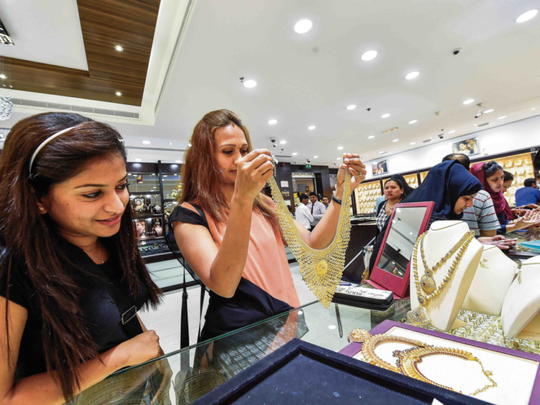
Dubai: Gold had a rollicking first quarter with global demand during the first quarter of 2016 totalling 1,290 tonnes from a 21 per cent increase over last year. This is the best first quarter performance put in by the metal in the first three months of the year and the second best quarterly showing ever in three decades, based on data from the World Gold Council.
The growth was brought on by investor demand, particularly buys made by gold-backed exchange traded funds (ETFs), which took in 364 tonnes and on par with volumes during the first quarter of 2009 when worries over the financial crisis had investors scrambling onto gold as a safe haven. And with the dollar’s strength starting to falter, gold was the go-to commodity. (In the first quarter of 2015, ETFs’ share was 25.6 tonnes.
More so, as prices were also recovering lost ground, gaining 17 per cent in the first three months. (Gold closed at $1,276.85 an ounce on Wednesday. On the last day of trading in 2015, it was at $1,060.) Investment-led demand accounted for 617.6 tonnes globally as against the 277.9 tonnes last year.
Such activity more than compensated for weak demand for jewellery from shoppers in China (down to 241.3 tonnes from the first quarter of 2015’s 275.4 tonnes) and India (116.5 tonnes from the 191.7 tonnes in the first quarter of 2015). Jewellery buying slipped even in the Middle East, to 79.3 tonnes from the 86.9 tonnes attained in the first quarter of 2015. (But the latest regional tally hews close to the five-year average of 79.1 tonnes. According to local retailers, jewellery sales in the UAE had a strong showing in January, tied to the DSF 2016 promotions, but slipped appreciably subsequently.) Worldwide, jewellery buying was down from the first quarter of 2015’s 596.9 tonnes to 481.9 tonnes It was heavy ETF buying up that sparked a rise in gold prices since the start of the year, and which did play a part in cramping demand among consumers in more price-conscious retail markets.
“With a rise in economic uncertainties and a shrinking pool of safe assets, professional investors were going back to the reliability gold offered,” said London-based John Mulligan, Head of Member and Investor Relations at WGC, in an interview with “Gulf News”.
Apart from the spike in prices, there were internal factors that held back jewellery demand in China and India. In the latter’s case, the strike called by gold retailers in March against the government’s 1 per cent excise levy on fabricated jewellery was a factor. “It severely disrupted supply and pushed up local prices, while rural incomes being affected by drought also led to much lower jewellery demand,” said Mulligan.
But with the strike since called off, chances are that demand would have got back on even keel during the recent “Akshaya Trithiya” phase and continue through the rest of the second quarter. (Hindu mythology has it that this is an auspicious period to buy precious metals.) According to Ramesh Kalyanaraman, Executive Director at Kalyan Jewllers, “[While] industry reports show there is a dip in sales compared to last year, there is — in India — a huge shift from unbranded jewellery houses to branded ones. But the retail pricing difference between buying in India and the Gulf is still there — by between 8-10 per cent.
“This extent of variation has happened only in the last five years; import duties were raised from 2 per cent to 8 per cent and then to 10 per cent.”
China too had to contend with its own factors curbing jewellery demand. The government move making it compulsory to hallmark 24-carat gold led to “jewellery being taken off to get the compliance approval”. “This added to a situation where consumer confidence is still shaken (over the economy) and by the turmoil in the stock markets.
“Even then, while jewellery demand dropped, there was still an increase in Chinese buyers buying gold as investment.”
BOX
Total supply for the first quarter of 2016 saw an increase of 5 per cent to 1,135 tonnes
Inflows into gold-backed ETFs (exchange traded funds) reached a seven-year high during Q1-16
The 17 per cent price run up in the first quarter “suppressed demand for bars and coins in the Middle East and Asia”, according to the World Gold Council. “This was to be expected among these particularly price sensitive markets, where demand typically subsides on a strong price rally before picking up again once the price stabilises”
India’s jewellery market has catching up to do in the second-half after jewellers’ strikes and high local prices put a catch on demand in the first quarter. “The industry expects the pent-up demand to be released in the coming weeks as the market adjusts to the new tax structure and buying for the wedding season gathers momentum,” WGC notes. “In 2015, demand in H1 slumped in the face of numerous challenges before staging a strong recovery in the second half; 2016 is likely to play out in a similar way.”











